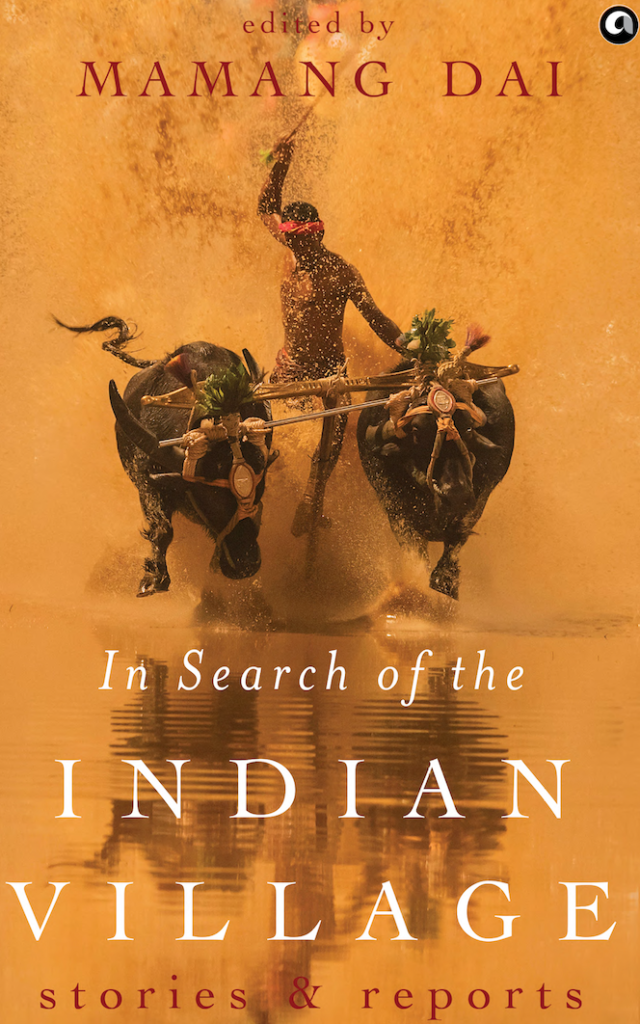In Search of the Indian Village: Stories and Reports is a compilation of fiction and non-fiction pieces. Featuring literary stalwarts like Ruskin Bond, Mahasweta Devi, Amitava Kumar, and more, this masterpiece takes the readers on a journey into the heart of India’s villages.
As I turned the pages of this book, I was captivated by the ever-changing landscape, settings, and demography.

Pic Credit: Aleph
Ruskin Bond’s The Blue Umbrella is a character-driven coming-of-age story about Binya, a young girl from the hills of Garhwal. Bond captures the essence of simplicity, the magic of human connections, and the beauty of nature and rural life in his trademark elegant style. Weaving together the themes of materialism, greed, generosity, contentment, and the transformative power of kindness, Bond delivers an evocative tale. This heart-warming story instills a belief in the inherent goodness of people and reminds us to be kind and cherish the simple pleasures of life.
Countless Hitlers, originally written in Rajasthani by Vijaydan Detha, is a gripping tale about complex social dynamics and the pursuit of wealth. Through rich descriptions, imagery, and insightful dialogues, the author transports readers to a rural village in Rajasthan. The story is much more than a simple account of five men buying a tractor; it symbolizes progress, hard work, societal change, and the eternal quest for modernity and fulfilment. The richly drawn characters, evocative settings, and thought-provoking themes make the narrative captivating.
Seeds by Mahasweta Devi is a hard-hitting story that exposes the exploitation faced by farmers from the hands of the rich and powerful. The narrative explores themes of oppression, resistance, caste-based discrimination, and the harsh realities experienced by marginalised communities in rural India. Devi’s skilled craftsmanship shines through in her portrayal of Dulan’s transformation from victim to rebel. His simple act of rebellion brings change in the community. In her signature style, Devi inspires readers to reflect on the struggle for equality. The ‘seed,’ in the story is not just a seed; it symbolises resistance and defiance.
Coinsanv’s Cattle by Damodar Mauzo tells the story of a poor family and their deep bond with their cattle. Set in a poor rural household in Goa, the narrative delves into the intricacies of human relationships. Hunger, poverty, resilience, and the symbiotic relationship between man and animal are other themes interwoven into this compelling narrative. The striking conclusion is a master stroke that leaves a lasting impression.
Set in the village of Paazhuthara, Kerala, The Hanging is a translation from Malayalam. O.V. Vijayan’s story explores grief, anguish, and despair. Vellaayiappan’s journey to meet his son who has been sentenced to death is heartbreaking. Poverty, oppression, an unjust legal system, human suffering, compassion, and the resilience of the human spirit are other themes intricately woven into the narration. Vijayan’s evocative narrative brought tears to my eyes.
Mohandas Karamchand Gandhi outlines his vision for rural independence and self-governance in his essay, My Idea of Village Swaraj. Self-rule, economic independence, self-sufficiency, sanitation, health, and the revival of Indian languages are a few of the topics covered in this essay.
The Village as the Nation: Making of the Indian Common Sense by Surinder S. Jodhkais examines the role of the Indian village in shaping national consciousness. This well-researched essay explores the idealized image of villages in India. Drawing from the perspectives of national leaders like Gandhi, Nehru, and Ambedkar the author provides a nuanced analysis of the complex relationship between villages and national identity.
Amitava Kumar’s The Rat’s Guide is a captivating exploration of his hometown, Patna. Kumar’s vivid narrative blends the personal and the universal. Navigating between the city’s past and the present, the author portrays the city’s complexities, historical significance, caste divide, power play, chaos, and contradictions. I was particularly intrigued by the snippets about Musahars.
Rahul M’s Oh, that house? It’s in the sea now – there! is a beautifully captivating piece that encapsulates environmental degradation and the destruction caused by it. Seeped in melancholic nostalgia, this essay offers a glimpse of eroding coastlines, shifting landscapes, and gradual loss. Piecing together personal anecdotes and historical context, Rahul M presents a frightening reality.
Despots, Distillers, Poets & Artists Characters of the countryside by P. Sainath offers a profound portrait of rural India. Bringing voices from Kalahandi to Manatu, Ramnad and Malkangiri, this informative piece is the voice of marginalised communities and offers fresh perspectives while challenging stereotypes about life in the countryside.
I highly recommend In Search of the Indian Village: Stories and Reports to readers fond of short stories or are interested in exploring the local flavours of India. This anthology celebrates the rich diversity of rural India and the enduring spirit of its people.
Rating: 4.5/5
Review author: Chandra Sundeep is an author, blogger, and book reviewer. Her short stories have been featured in various anthologies, online portals, and literary magazines. In 2023, she received the Bharat Award, recognizing her dedication to impactful storytelling. Additionally, she has been a recipient of esteemed awards such as the Asian Literary Society’s Sagar Memorial Award, Wordsmith Award, and Gitesh-Biva Memorial Award in 2021 and 2022.